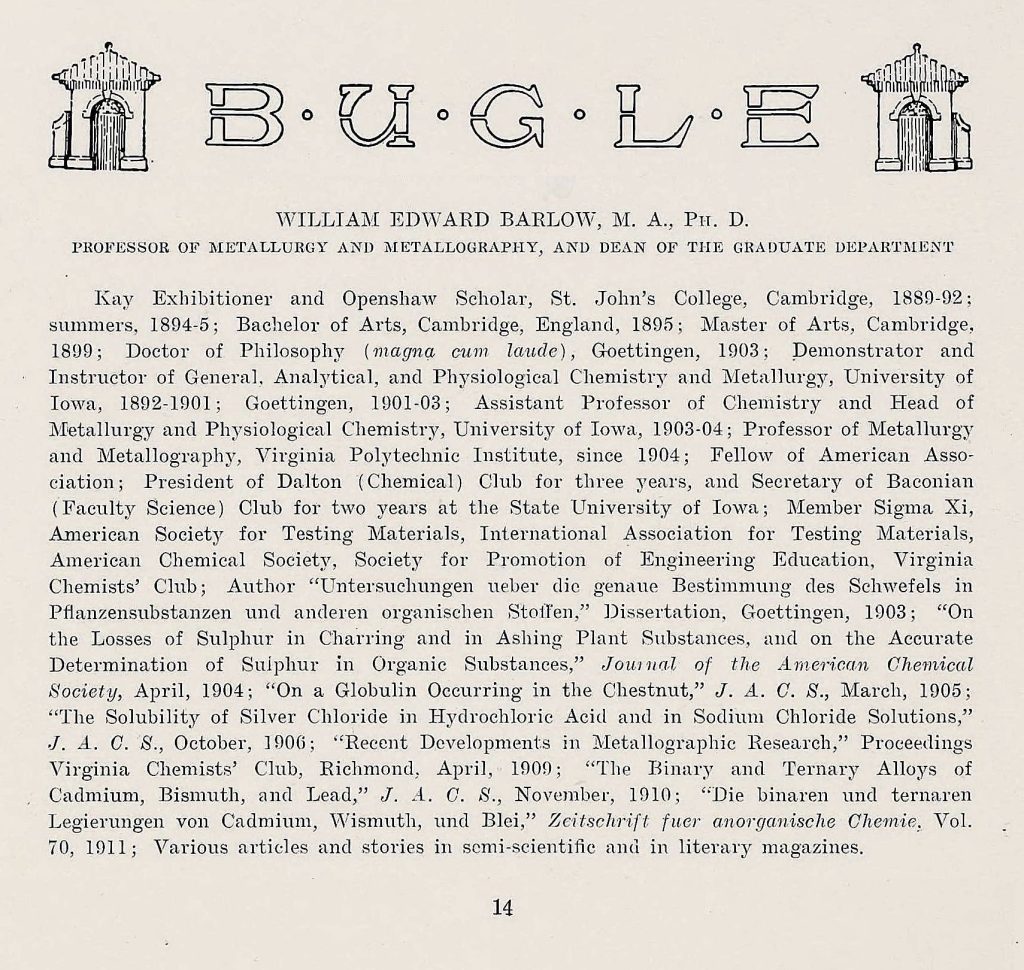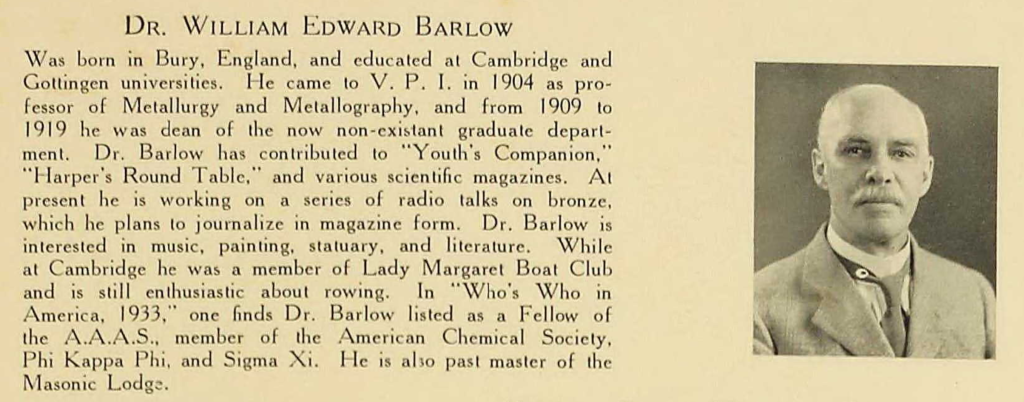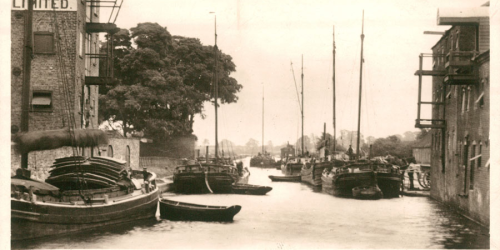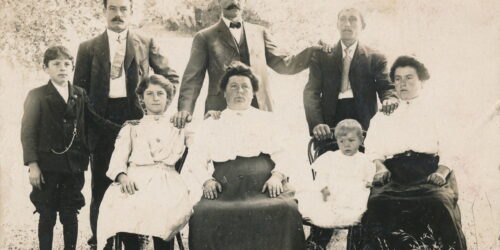Dr William Barlow & Virginia Tech

William Edward Barlow (1870-1938) was born in Bury, Lancashire, the eighth of ten children to our 3rd Great Grandparents William Smyth BARLOW (1830-1903) and Mary YATES (1830-1916). The family ran a successful Letterpress Photographic Printing, Framing, & Stationary business.
William studied at the private school, Bury Grammar for Boys, before being awarded the Kay Exhibitioner and Openshaw Scholarship to St. John’s College, Cambridge, 1889-92, studying for the Natural Science Tripos (NST).
The NST is the framework within which most of the science at the University of Cambridge is still taught. The tripos includes a wide range of Natural Sciences from physics, astronomy, and geoscience, to chemistry and biology, which are taught alongside the history and philosophy of science. The tripos is known for its broad range of study in the first year, in which students choose three courses in different areas of the natural sciences and one in mathematics. The degree awarded after Part II (three years of study) is a Bachelor of Arts (BA). A Master of Natural Sciences degree (MSci) is available to those who take the optional Part III (one further year).
In addition to academic endeavors, William was also a keen oarsman and a member of the Lady Margaret Boat Club. Founded by twelve members of St John’s College, LMBC was the first college boat club in Cambridge.
However, after fifteen years of full time education, and (we assume) high expectations from parents and educators alike, William decided to take a sabbatical from education. This sabbatical is conjecture as I attempt to determine what events drove William to relocate to Iowa, USA.
Boarding a transatlantic steamship in Liverpool, 1892, William traveled to the new world and the United States of America.
Taking the transcontinental railroad from New York to Utah and then Colorado, we suspect he was visiting well publicized mining operations as chemistry, and specifically metallurgy and metallography, were his research focus.
At this time, The Silver King Mine was one of the big three mines to make Park City, Utah, the world’s most profitable mining camps of the era. William may have also visited the copper mines of Bingham Canyon, the largest copper mines in the world, where the Marchetti & Togliatti families would later work.
In Colorado the last great gold rush had begun in 1890 in Cripple Creek. Attracting prospectors and realtors alike, the population rocketed from 500 to 10,000 by the time William would have visited.


Instead of returning home, William travelled to Iowa City, became an instructor in chemistry at the State University of Iowa, and settled there until 1901. I am currently unable to determine why William chose Iowa City but he did marry Miss Bernice Gertrude Whiting of Clermont, Iowa, in 1893, less than a year after his arrival in the city. He was able to return to Cambridge University periodically to complete his degree between semesters of teaching.
Returning to Europe in 1901, William spent two years at the University of Goettingen, Germany, from which he received his Ph.D. degree in 1903. He then returned to Iowa University as assistant professor of chemistry and Head of Metallurgy and Physiological Sciences. However his tenure was short-lived as the family relocated to Blacksburg, Montgomery County, Virginia, lured by the prospect of employment at the prestigious educational institution of Virginia Polytechnic Institute (VPI), now known as Virginia Tech.

1. Barlow Mr William E… Age 33 Yrs, 1 Mos; Male; Married; Professor of Chemistry; Able to Read & Write; Nationality – England; Race – English; Last Residence – Gottingen Germany since August 1901; Final Destination – Iowa City, IA; No ticket to final destination, Passage paid by self; $400 in pocket; Previous visits to USA from 1891/1901 Iowa City, IA; Address – Iowa City, Iowa; Prison? No; Polygamist? No; Anarchist? No; …coming by reason of any solicitation to labor in the US? No; Condition of health? Good; Deformed or Crippled? No.

US Citizens – Sworn
4. Barlow Mrs B Gertrude… Age 30 Yrs, 2 Mos;
5. Barlow Miss H Gertrude… Age 5 Yrs, 6 Mos;
There are few passenger records for William’s transatlantic journeys and only one included his wife and daughter, so we must assume he traveled alone to complete his degree in Cambridge. However both Mrs B Gertrude & Miss H Gertrude Barlow are on the SS Teutonic passenger list, on a separate list of US Citizens, departing Liverpool in July 1903, on their return from Germany to Iowa. Whilst in Europe, William would have been able to introduce his wife and daughter to his parents and family in Bury, hopefully before his father’s passing in March 1903. Their second child, Wallace, did not arrive until 1909 after the family had settled in Virginia.
Doctor William Edward Barlow quickly rose from Assistant to Associate and finally full Professor of Metallurgy and Metallography at VPI by 1906. Additionally William established the Graduate Department, becoming the first Dean from 1907 to 1919, and continued to publish original research in the Journal of the American Chemical Society.

The family remained on the VPI campus until William’s death in 1938. His widow Bernice Gertrude moved in with their son Wallace in Massachusetts before the outbreak of WWII and would be buried alongside William in Salem City, Virginia, when she passed away in 1950, aged 77.
Wallace served during WWII along with his brother-in-law Herbert Sitwell and nephew George Sitwell. They all returned home safely to their families.
I first heard about the American Barlow family in ~2005. My grandmother explained when our 3rd Great Grandparents, William Smyth BARLOW & Mary YATES, passed away the inheritance from their successful print business was split between the three sons; Frederick Blunstone Barlow, William Edward Barlow, & Tom Gilbert Barlow. Our grandmother was particularly vexed that none of the inheritance came to our family in York, specifically her grandmother, Mary BARLOW.

The Bugle 1915, Volume 21, VPI, Blacksburg, Virginia

PROFESSOR OF METALLURGY AND METALLOGRAPHY, AND DEAN OF THE GRADUATE DEPARTMENT Kay Exhibitioner and Openshaw Scholar, St. John’s College, Cambridge, 1889-92; summers, 1894-5; Bachelor of Arts, Cambridge, England, 1895; Master of Arts, Cambridge. 1899; Doctor of Philosophy (magna cum laude), Goettingen, 1903; Demonstrator and Instructor of General, Analytical, and Physiological Chemistry and Metallurgy, University of lowa, 1892-1901; Goettingen, 1901-03; Assistant Professor of Chemistry and Head of Metallurgy and Physiological Chemistry, University of Iowa, 1903-04; Professor of Metallurgy and Metallography, Virginia Polytechnic Institute, since 1904; Fellow of American Association: President of Dalton (Chemical) Club for three years, and Secretary of Baconian (Faculty Science) Club for two years at the State University of Iowa; Member Sigma Xi American Society for Testing Materials, International Association for Testing Materials, American Chemical Society, Society for Promotion of Engineering Education, Virginia Chemists’ Club: Author “Untersuchungen ueber die genaue Bestimmung des Schwefels in Pflanzensubstanzen und anderen organischen Stoffen,” Dissertation, Goettingen, 1903; “On the Losses of Sulphur in Charring and in Ashing Plant Substances, and on the Accurate Determination of Sulphur in Organic Substances,” Journal of the American Chemical Society, April, 1904; “On a Globulin Occurring in the Chestnut,” J. A. C. S., March, 1905; “The Solubility of Silver Chloride in Hydrochloric Acid and in Sodium Chloride Solutions,” J. A. C. S., October, 1906; “Recent Developments in Metallographic Research,” Proceedings Virginia Chemists’ Club, Richmond, April, 1909; “The Binary and Ternary Alloys Cadmium, Bismuth, and Lead,” J. A. C. S., November, 1910; “Die binaren und ternaren Legierungen von Cadmium, Wismuth, und Blei,” Zeitschrift fuer anorganische Chemie, Vol. 70, 1911: Various articles and stories in semi-scientific and in literary magazines.
Dr William Edward Barlow, 1933 School Yearbook, VPI, Blacksburg, Virginia

Obituary, The Roanoke Times, 31 Dec 1938
Dr. William Edward Barlow
In the death of Dr. W. E. Barlow, professor of metallurgy and metallography, on December 22, the faculty of the Virginia Polytechnic Institute suffered an irreparable loss. Not only was Dr. Barlow a distinguished scientist and scholar; he was also an inspiring teacher, a man of broad interests and culture, and a Christian gentleman whose sterling character impressed itself on all who had the privilege of knowing him.
William Edward Barlow was born in Bury, Lancashire, England, on May 11, 1870, the son of William Smythe and Mary Yates Barlow. He received his early education at the Bury School and in 1889 was awarded both the Key Exhibition and the Openshaw Scholarship at Cambridge University. He entered St. John’s College, Cambridge, and began studying for the Natural Science Tripos. In 1892 he left England for travel and rest; after spending several months in Utah and Colorado, he became an instructor in chemistry at the State University of Iowa, where he remained until 1901.
Meanwhile, in 1893 Dr. Barlow married Miss Bernice Whiting of Clermont, Iowa; he also returned to Cambridge at intervals, taking his B. A. degree (first class) in 1895 and his M. A. degree in 1899. Securing a leave of absence from the University of Iowa in 1901, he went to Germany and spent two years at the University of Goettingen, from which he received his Ph.D. degree (magna cum laude) in 1903. He then returned to Iowa University as assistant professor of chemistry.
Dr. Barlow came to Virginia Polytechnic Institute in 1904 as assistant professor of industrial chemistry and metallurgy. He became assoclate professor at the end of the year and was made professor of metallurgy and metallography in 1906. Not only did Dr. Barlow initiate the study of metallography at Virginia Tech; he also developed the work in metallurgy from a single course to an independent curriculum leading to a degree. From 1908 to 1919 he was dean of the graduate department. He also found time for much original research in his chosen fleld, the results of which were published chiefly in the Journal of the American Chemical Society. At the time of his death he was a fellow of the American Association for the Advancement of Sclence, a member of the Sigma Xi and Phi Kappa Phi honor societies, an Episcopalian, and a Mason.
Dr. Barlow is survived by his wife: a daughter. Mrs. Fitzroy Sitwell, of Bedford; a son, Wallace Dudley, of Roanoke: three sisters, Bertha, Clara, and Katie, and a brother, Tom, all of Lancashire, England.
The Roanoke Times, 31 Dec 1938, Sat · Page 6
Family Tree
Our 3rd Great Grandparents William Smyth BARLOW & Mary YATES ran a Printing and Stationary business in Bury, Lancashire. Our 2nd Great Grand Uncle, William Edward Barlow, was the eighth child. Our direct family line descends from their fourth child, our 2nd Great Grandmother Mary BARLOW. Mary became a teacher, married a colleague James HARDACRE and relocated to Nether Poppleton, just outside York, to raise their family.
- William Smyth BARLOW (~1830-1903) & Mary YATES (~1830-1916)
- Elizabeth Helen Barlow (1851-1936)
- Annie Lawson Barlow (1853-)
- Effie Maud Barlow (1858-1934)
- Mary BARLOW (1860-1930) & James HARDACRE (1861-1947)
- Gilbert Clapham Hardacre (1889-1959)
- Elsie Mary HARDACRE (1892-1963) & Bernard HUDSON (1888-1939)
- Sheila Mary HUDSON (1925-2016) & Albert Wear CLARK (1921-1983)
- Our direct line…
- Sheila Mary HUDSON (1925-2016) & Albert Wear CLARK (1921-1983)
- Geoffrey Ronald Hardacre (1900-1977) & Doris Bartley (1899-1990)
- Frederick Blunstone Barlow (1863-)
- Clara Barlow (1864-1945)
- Bertha Barlow (1867-?)
- William Edward Barlow (1870-1938) & Bernice Gertrude Whiting (1873-1950)
- Helen Gertrude Barlow (1897-1955) & Herbert Cecil Fitzroy Sitwell (1895-1965)
- George Fitzroy Sitwell (1923-1980) & Elizabeth Ann Freed (1925-?)
- Elizabeth Barlow Sitwell (1951-1999)
- George Fitzroy Sitwell (1923-1980) & Elizabeth Ann Freed (1925-?)
- Wallace Dudley Barlow (1909-1985) & Barbara Porter Lincoln (1926-1972)
- Elizabeth Lincoln Barlow (1949-?)
- Helen Gertrude Barlow (1897-1955) & Herbert Cecil Fitzroy Sitwell (1895-1965)
- Tom Gilbert Barlow (1872-?)
- Katie Barlow (1877-?)
References
- Bury Grammar School, Wikipedia
- Natural Sciences Tripos (NST), Cambridge University, Wikipedia
- Lady Margaret Boat Club, Cambridge University
- Silver King Mine, Park City, Utah, Visit Park City
- Silver King Mine, Park City History
- Timeline of mining in Colorado, Wikipedia
- Cripple Creek, Colorado, Wikipedia
- University of Iowa, Iowa City, Wikipedia
- Virginia Tech (VT), formally the Virginia Polytechnic Institute and State University (VPI), Wikipedia
- University of Göttingen, Wikipedia
- WILLlAM EDWARD BARLOW, M.A., PhD., Associate Professor of Metallurgy and Metallography, The Bugle 1907, Virginia Polytechnic Institute, Blacksburg, Virginia
- Barlow, William E.—Graduate Department (1907-20), Academic Deans, Virginia Tech
- Heads of the Graduate School: William E. Barlow — dean (1907-20), The Graduate School, Virginia Tech
- William E. Barlow — dean (1907-20), Past Deans and Leaders of Graduate Education At Virginia Tech
- Graduate Department established 1907 with William E. Barlow serving as the first dean, History of Graduate Education at Virginia Tech
- William Edward Barlow M.A. Ph.D, Educational Resumé, The Bugle 1915, Volume 21, Virginia Polytechnic Institute, Blacksburg, Virginia
- WILLIAM EDWARD BARLOW, MA,. Ph.D., Metallurgy and Metallography, Head of Department, The Tin Horn 1930, Yearbook of the Co-Eds, Virginia Polytechnic Institute, Blacksburg, Virginia
- Dr William Edward Barlow Obituary, The Roanoke Times, 31 Dec 1938, Sat · Page 6
- Dr William Edward Barlow, FindaGrave.com






Revised to include Gertrude & Gertrude’s passenger record in 1903 traveling from Liverpool to New York with William aboard the SS Teutonic (on the US Citizen list)